What do storm chasers really do? Two tornado scientists take us inside the chase and tools for study
To capture the data needed to understand how tornadoes behave, scientists have to be near the storm. The ‘Twister’ movies get some of it right.
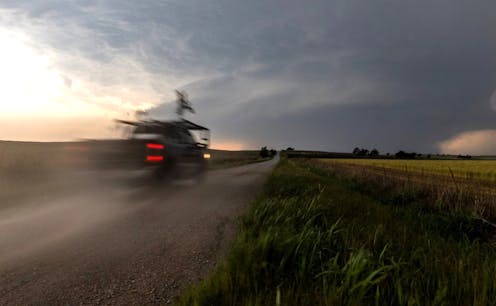
Storm-chasing for science can be exciting and stressful – we know, because we do it. It has also been essential for developing today’s understanding of how tornadoes form and how they behave.
In 1996 the movie “Twister” brought storm-chasing into the public imagination as scientists played by Helen Hunt and Bill Paxton raced ahead of tornadoes to deploy their sensors and occasionally got too close. That movie inspired a generation of atmospheric scientists.
With the new movie “Twisters” coming out on July 19, 2024, we’ve been getting questions about storm-chasing – or storm intercepts, as we call them.
Here are some answers about what scientists who do this kind of fieldwork are up to when they race off after storms.
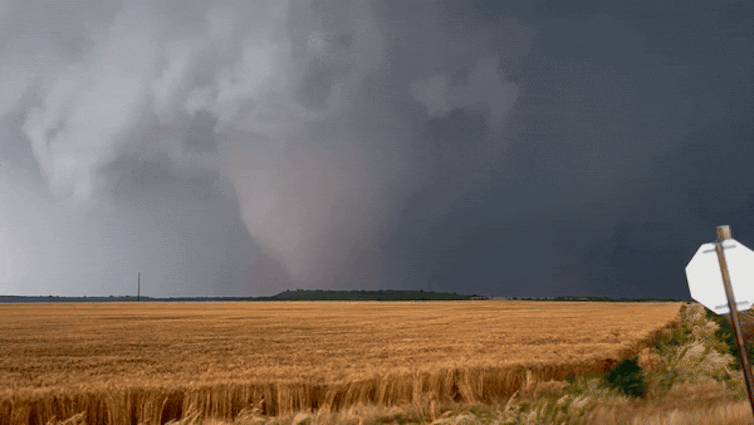
What does a day of storm-chasing really look like?
The morning of a chase day starts with a good breakfast, because there might not be any chance to eat a good meal later in the day.
Before heading out, the team looks at the weather conditions, the National Weather Service computer forecast models and outlooks from the National Oceanic and Atmospheric Administration’s Storm Prediction Center to determine the target.
Our goal is to figure out where tornadoes are most likely to occur that day. Temperature, moisture and winds, and how these change with height above the ground, all provide clues.
There is a “hurry up and wait” cadence to a storm chase day. We want to get into position quickly, but then we’re often waiting for storms to develop.
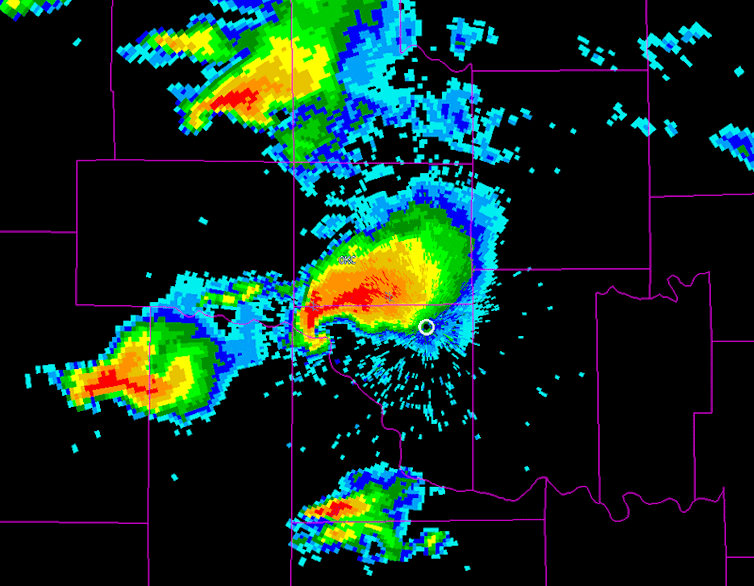
Storms often take time to develop before they’re capable of producing tornadoes. So we watch the storm carefully on radar and with our eyes, if possible, staying well ahead of it until it matures. Often, we’ll watch multiple storms and look for signs that one might be more likely to generate tornadoes.
Once the mission scientist declares a deployment, everyone scrambles to get into position.
We use a lot of different instruments to track and measure tornadoes, and there is an art to determining when to deploy them. Too early, and the tornado might not form where the instruments are. Too late, and we’ve missed it. Each instrument needs to be in a specific location relative to the tornado. Some need to be deployed well ahead of the storm and then stay stationary. Others are car-mounted and are driven back and forth within the storm.
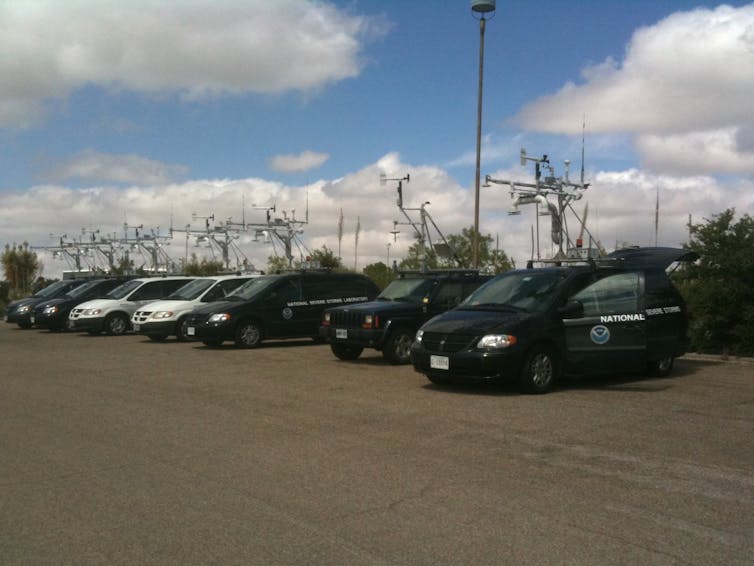
If all goes well, team members will be concentrating on the data coming in. Some will be launching weather balloons at various distances from the tornado, while others will be placing “pods” containing weather instruments directly in the path of the tornado.
A whole network of observing stations will have been set up across the storm, with radars collecting data from multiple angles, photographers capturing the storm from multiple angles, and instrumented vehicles transecting key areas of the storm.
Not all of our work is focused on the tornado itself. We often target areas around the tornado or within other parts of the storm to understand how the rotation forms. Theories suggest that this rotation can be generated by temperature variations within the storm’s precipitation region, potentially many miles from where the tornado forms.
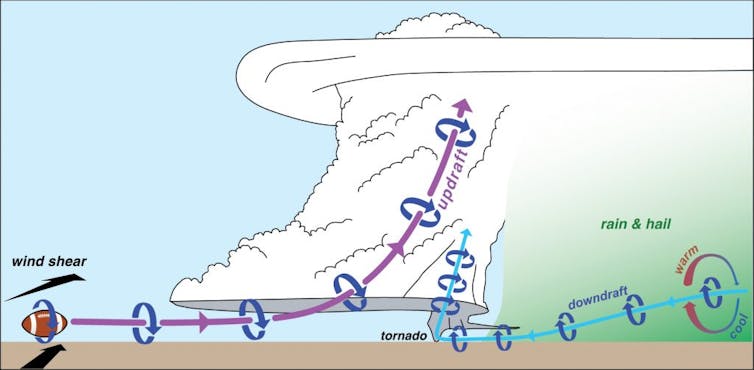
Through all of this, the teams stay in contact using text messages and software that allows us to see everyone’s position relative to the latest radar images. We’re also watching the forecast for the next day so we can plan where to go next and find hotel rooms and, hopefully, a late dinner.
What do all those instruments tell you about the storm?
One of the most important tools of storm-chasing is weather radar. It captures what’s happening with precipitation and winds above the ground.
We use several types of radars, typically attached to trucks so we can move fast. Some transmit with a longer wavelength that helps us see farther into a storm, but at the cost of a broader width to their beam, resulting in a fuzzier picture. They are good for collecting data across the entire storm.
Smaller-wavelength radars cannot penetrate as far into the precipitation, but they do offer the high-resolution view necessary to capture small-scale phenomena like tornadoes. We put these radars closer to the developing tornado.
We also monitor wind, air pressure, temperature and humidity along the ground using various instruments attached to moving vehicles, or by temporarily deploying stationary arrays of these instruments ahead of the approaching storm. Some of these are meant to be hit by the tornado.
Weather balloons provide crucial data, too. Some are designed to ascend through the atmosphere and capture the conditions outside the storm. Others travel through the storm itself, measuring the important temperature variations in the rain-cooled air beneath the storm. Scientists are now using drones in the same way in parts of the storm.

All of this gives scientists insight into the processes happening throughout the storm before and during tornado development and throughout the tornado’s lifetime.
How do you stay safe while chasing tornadoes?
Storms can be very dangerous and unpredictable, so it’s important to always stay on top of the radar and watch the storm.
A storm can cycle, developing a new tornado downstream of the previous one. Tornadoes can change direction, particularly as they are dying or when they have a complex structure with multiple funnels. Storm chasers know to look at the entire storm, not just the tornado, and to be on alert for other storms that might sneak up. An escape plan based on the storm’s expected motion and the road network is essential.
Scientists take calculated risks when they’re storm chasing – enough to collect crucial data, but never putting their teams in too much danger.
It turns out that driving is actually the most dangerous part of storm-chasing, particularly when roads are wet and visibility is poor – as is often the case at the end of the day. During the chase, the driving danger can be compounded by erratic driving of other storm chasers and traffic jams around storms.
What happens to all the data you collect while storm-chasing?
It would be nice to have immediate eureka moments, but the results take time.
After we collect the data, we spend years analyzing it. Combining data from all the instruments to get a complete picture of the storm and how it evolved takes time and patience. But having data on the wind, temperature, relative humidity and pressure from many different angles and instruments allows us to test theories about how tornadoes develop.
Although the analysis process is slow, the discoveries are often as exciting as the tornado itself.
Yvette Richardson receives funding from the National Science Foundation and previously received funding from the National Oceanic and Atmospheric Administration. She is a member of the American Meteorological Society, the National Weather Association, and the American Geophysical Union, and serves on the Board of Trustees for the University Corporation for Atmospheric Research.
Paul Markowski receives funding from the National Science Foundation and previously received funding from the National Oceanic and Atmospheric Administration. He is a member of the American Meteorological Society, National Weather Association, and is affiliated with the University Corporation for Atmospheric Research.
Read These Next
West Antarctica’s history of rapid melting foretells sudden shifts in continent’s ‘catastrophic’ geo
A picture of what West Antarctica looked like when its ice sheet melted in the past can offer insight…
As DOJ begins to release Epstein files, his many victims deserve more attention than the powerful me
Powerful men connected to Jeffrey Epstein are named, dissected and speculated about. The survivors,…
Autocracies in transition: In 2025, Cameroon and Tanzania rulers clung to power — but look more vuln
The countries, whose respective leaders recently won widely disputed elections, offer contrasting examples…






